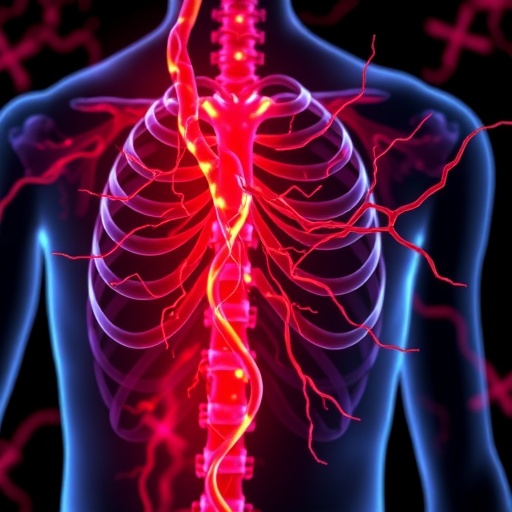In a groundbreaking advancement poised to reshape regenerative medicine, researchers from The Fourth Military Medical University in Xi’an, China, have unveiled a novel cellular interaction critical to periodontal tissue regeneration. Through the sophisticated application of single-cell transcriptomics, combined with rigorous bioinformatic analyses and in vivo experiments, the team identified a unique crosstalk between mesenchymal stem/stromal cells (MSCs) marked by PDGFRA expression and endothelial cells (ECs) mediated by growth factors VEGFA and PDGFBB. This paracrine signaling axis not only sustains MSC functionality but also orchestrates angiogenesis-osteogenesis coupling, crucial for regenerating periodontal bone—a feat that could revolutionize therapies addressing oral tissue loss.
Stem cells are the cornerstone of regenerative medicine, offering immense therapeutic promise due to their ability to differentiate and modulate tissue environments. Among these, mesenchymal stem/stromal cells exhibit a remarkable capacity for organization and tissue assembly, particularly evident in their propensity for cell condensation—a biological process where stem cells aggregate to form dense clusters. This mesenchymal condensation is pivotal during organogenesis, facilitating the establishment of signaling niches that attract progenitor populations across lineages. The ability to harness this intrinsic behavior of MSCs in vitro to boost regeneration of complex tissue structures, including teeth, introduces transformative possibilities for treating periodontal bone defects that currently pose significant clinical challenges.
During natural tooth development, mesenchymal condensation occurs within an initially avascular environment, orchestrated by reciprocal signaling between dental epithelium and underlying mesenchyme. This condensate then recruits endothelial progenitor cells, a critical event promoting neovascularization within the forming dental structures. Yet, despite its fundamental importance, the precise molecular mediators and intercellular dialogues between the mesenchymal and endothelial components involved in this regenerative milieu have remained elusive. Understanding this crosstalk is essential to replicate and enhance these processes therapeutically.
Addressing this knowledge gap, the research spearheaded by Drs. Fang Jin, Bingdong Sui, and Chenxi Zheng employed single-cell RNA sequencing to deconvolute the heterogeneity within dental follicle and dental papilla tissues—two key progenitor-rich zones in postnatal human tooth development. This cutting-edge approach enabled the precise profiling of gene expression at single-cell resolution, revealing overlapping stem cell populations underpinning dental progenitor identity. Among the thousands of genes analyzed, platelet-derived growth factor receptor alpha (PDGFRA) emerged as a distinctive surface marker consistently expressed in both dental follicle stem cells (DFSCs) and stem cells from apical papilla (SCAP), signifying a common MSC pool central to dental tissue regeneration.
Bioinformatic interrogation and subsequent biological assays uncovered a nuanced paracrine network: PDGFRA-positive MSCs engage in bidirectional signaling with CD31-positive, endomucin-positive endothelial cells. Specifically, endothelial cells secrete PDGFBB, which acts on MSCs to maintain their regenerative competency, while MSCs produce vascular endothelial growth factor A (VEGFA), promoting EC-mediated angiogenesis. This reciprocal exchange fosters a microenvironment conducive to robust vascular and osteogenic development, effectively coupling new blood vessel formation with bone regeneration—an orchestrated symbiosis crucial in periodontal repair.
Crucially, the team validated this cellular interplay through meticulous in vivo experiments involving donor-recipient models of bone regeneration. Implanted PDGFRA-positive MSC aggregates persisted within host environments and secreted factors that intensified angiogenic responses. Remarkably, these MSC clusters appeared to stimulate endothelial cells to produce PDGFBB, reinforcing a feedback loop essential for sustaining both cell types’ functions. The continuity of this signaling axis accelerated the healing of periodontal defects, underscoring its therapeutic relevance and potential scalability.
This discovery not only clarifies the molecular choreography underlying mesenchymal-endothelial interactions during odontogenic condensation but also introduces a compelling target for clinical intervention. By leveraging PDGFRA-positive MSCs and modulating their crosstalk with endothelial cells, future regenerative therapies may achieve unprecedented precision in restoring complex oral tissues damaged by disease or trauma.
The implications of this research stretch beyond dentistry. Angiogenesis and osteogenesis coupling are fundamental to the regeneration of numerous tissues and organs. Harnessing progenitor cell networks orchestrated by PDGFRA and VEGFA/PDGFBB signaling could spearhead advances in broader biomedical engineering and tissue engineering fields, offering new avenues for treating ischemic conditions, bone fractures, and degenerative diseases.
Moreover, the elucidation of these intricate signaling pathways illuminates the sophisticated communication networks innate to stem cell niches. It underscores the importance of cellular heterogeneity and microenvironmental context in regenerative outcomes—factors that are increasingly recognized as vital to the success of stem cell-based therapies.
Technical prowess such as single-cell transcriptomics, combined with functional assays and animal models, exemplifies the multidisciplinary approach required to decode complex biological systems. This convergence of high-resolution genomics and translational experimentation sets a new standard for uncovering fundamental regenerative mechanisms and propelling them towards clinical application.
Looking forward, optimizing conditions to cultivate and transplant PDGFRA-positive MSC aggregates, alongside fine-tuning endothelial cell responses, will be critical for developing scalable, effective regenerative treatments. Integrating these insights with biomaterials and scaffold technologies could further enhance tissue integration and functional restoration.
In sum, the study conducted by Dr. Jin and colleagues represents a major stride in understanding and utilizing the mesenchymal-endothelial dialogue that governs periodontal tissue regeneration. Their findings herald a new chapter in regenerative dentistry and stem cell research, with wide-reaching potential to transform therapeutic strategies aimed at restoring form and function to damaged tissues.
Subject of Research: Cells
Article Title: Single-cell transcriptomics identifies PDGFRA+ progenitors orchestrating angiogenesis and periodontal tissue regeneration
News Publication Date: 24-Jul-2025
Web References:
https://doi.org/10.1038/s41368-025-00384-6
References:
DOI: 10.1038/s41368-025-00384-6
Image Credits:
Credit: Dr. Fang Jin from The Fourth Military Medical University, Xi’an, China
Keywords:
Regenerative medicine, Bone formation, Angiogenesis, Stem cells, Mesenchymal stem cells, Tissue engineering, Biomedical engineering, Dentistry, Cell biology, Biotechnology, Bone tissue, Molecular biology




